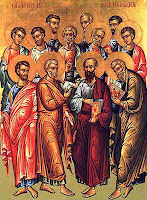While we proclaim the sprouting and infancy of
the Church in the Season of Apostles, along the weeks of Summer we commemorate
her maturity and fruitfulness. The
Syriac term Qaita means “summer.” It
is during Summer that the grains and fruits ripen and mature. Thus the name indicates that it is a season
of plentiful harvest for the Church.
“The fruits of the
Church are that of Holiness and Martyrdom.
The Church, having grown, developed and spread to different parts of the
world, shines forth as the image of the heavenly Kingdom giving birth to very
many saints and martyrs. This reality of
the Church is proclaimed during the Season of Summer.”
THE TWELVE APOSTLES
This Season begins, celebrating the
feast of the twelve Apostles. There are
also documents that describe the first Sunday of Summer as the last Sunday of
Apostles. Since there is continuity
between these two Seasons, it is quite meaningful that they meet in one feast.
“The Apostles are the
foundation of the Church, while Iso’ -Msiha himself is the corner stone. It is impossible for the Church to dream
about a holiness and spiritual maturity apart from the Apostles.”
NUSARDEIL
In all official liturgical books, the
first Sunday of Summer is also marked Nusardeil. It is a Persian word and it means, “God-given
New Year Day.”
If it is so, the first Sunday of
Summer could be very well considered as an important feast day which unites
together God, namely, Iso’-Msiha, the “God with us”, his twelve Apostles
and the Church built upon them. Since a
few years, they do not mark this on the Syro-Malabar Liturgical Calendar.
FEAST OF THE SAINTS
It is quite natural that Saints and Martyrs are specially
honoured in this particular Season. As
in the Season of Denha, in the Summer
too, Fridays are set apart for such
celebrations.
Among these feasts, one that is to be
specially mentioned is the Feast of Mar
Mari, one of the Apostles of the East. This Feast is celebrated on the Second Friday. According to the liturgical books, he is a
disciple of Mar Addai.
The other Saints celebrated are, Mar
Jacob of Nisibis (first Friday), Marta
Simoni and her Seven Children (fifth
Friday), Mar Simon Bar Sabbai and Friends
(sixth Friday) and Sahda Mar Quardag (seventh
Friday).
BLESSED ALPHONSA
Bl.
Alphonsa was crowned with eternal glory on July 28, 1946. Hence July 28 is a great Feast-Day for the Mar Toma Nazranees.
TRANSFIGURATION OF OUR
LORD
The Feast of Transfiguration (August 6), which for Eastern Churches, is
one of the most important celebrations in the Liturgical Year, comes usually
during this Season. The biblical episode
of Transfiguration (Mt 17, 1-9; Mk 9, 1-9; Lk 9, 28-36) is self-expressive.
In its liturgical celebration, we proclaim the human divinization that
happens when the salvific action perfected in Iso’-Msiha works in men
by the power of the Holy Spirit. This
celebration, therefore, is considered as one of the six principal moments of
the Salvation History.
When Iso’-Msiha was transfigured
on Mount Tabor, Eliyah and Moses, as the representatives of the Old Testament,
appeared there; the representatives of the New Testament, the three Apostles
were also there. The glorious Cross is the icon or sacrament of risen Lord and
all Eastern Churches understand this symbolism perfectly well. Thus the two Seasons, which follow the Season
of Summer, namely, of Eliyah-Sliba and Muse are emphasized in celebrating this biblical episode of
Transfiguration.
“What is proclaimed in
this “feast celebration” is the eschatological dimension of the History of
Salvation. Such pauses and celebrations
inspire and encourage men who live always according to worldly ways and standards. Mar Toma Nazranees also must celebrate this
Feast most solemnly.”
ASSUMPTION OF OUR LADY
Another important feast that comes in
this Season is that of the Assumption of
our Lady (August 15). The Fifteen-Day-Fast in preparation for this
Feast itself indicates the importance given to it in the Mar Toma Margam. This
official fasting proves that Mar Toma
Nazranees always revere and venerate the Mother of Iso’-Msiha most
becomingly in their liturgical year. This feast celebration is also an emphasis
and guarantee of the eschatological dimension of our Christian existence.
“August 15th is also
the National Independence Day for Mar Toma Nazranees. It is, indeed, a blessing and highly
providential that these two symbols of spiritual and physical liberation were
united in celebration on this particular day.”





The in depth interpretation of Fr.Pathikulangara,about the ( celebration of) )'Seasons' in East Syrian Liturgy, with special reference to SMC, is quite rational & in accordance with Scriptures.
ReplyDeleteAs per my knowledge,no official instruction /directive from the Major Archbishop,in these lines.
Also,the meaning of the term'Marthoma Margam ( Way of St.Thomas),should not be limited to liturgy only.